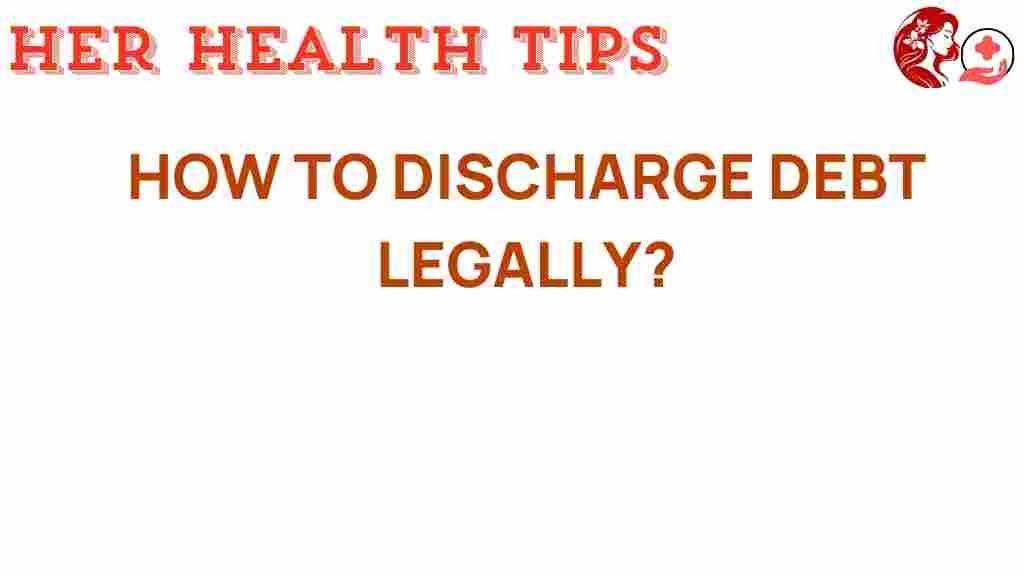Unraveling the Secrets: How to Discharge Debt Legally and Effectively
Debt can weigh heavily on individuals and families, often leading to stress and anxiety. The good news is that there are ways to discharge debt legally and effectively. Understanding the process of debt discharge, exploring bankruptcy options, and implementing credit management strategies can pave the way toward financial freedom. In this comprehensive guide, we will delve into various legal debt relief options, including debt negotiation and financial strategies, to help you regain control of your finances.
The Importance of Financial Freedom
Financial freedom means having enough savings, investments, and cash on hand to afford the lifestyle you want for yourself and your family. It also means being able to manage your debts effectively without falling into financial traps. Discharging debt legally is a crucial step in achieving this freedom. Let’s explore how you can do this.
Understanding Debt Discharge
Debt discharge refers to the legal elimination of a debt obligation. This means that the debtor is no longer legally required to pay the debt. Here’s how it works:
- Debt can be discharged through various means, including bankruptcy, debt negotiation, and settlement agreements.
- Not all debts are dischargeable. For example, student loans and certain taxes may not be eligible for discharge under bankruptcy laws.
- A proper understanding of your financial situation is essential to determine the best course of action.
Bankruptcy Options
Bankruptcy is a legal process that provides relief to individuals and businesses facing overwhelming debt. There are several types of bankruptcy options available:
- Chapter 7 Bankruptcy: This is known as liquidation bankruptcy. It involves selling non-exempt assets to pay off debts. Once the assets are liquidated, most unsecured debts are discharged.
- Chapter 13 Bankruptcy: This option allows individuals to reorganize their debts and create a repayment plan over three to five years. After successfully completing the plan, remaining eligible debts are discharged.
- Chapter 11 Bankruptcy: Typically used by businesses, this allows for reorganization of debts while continuing operations.
Choosing the right bankruptcy option depends on your financial situation and the type of debt you have. Consulting with a bankruptcy attorney can provide valuable insights.
Legal Debt Relief Options
If bankruptcy isn’t the right path for you, there are other legal debt relief options to consider:
Debt Negotiation
Debt negotiation involves contacting creditors to negotiate lower payments or reduced balances. This can be done on your own or through a debt negotiation service. Here are some steps to follow:
- Gather your financial information, including income, expenses, and debt amounts.
- Contact your creditors to discuss your financial situation.
- Propose a reduced payment or settlement amount that you can afford.
- Get any agreements in writing to avoid future disputes.
Credit Management Strategies
Effective credit management is vital for maintaining a healthy financial status. Here are some strategies you can implement:
- Create a Budget: Track your income and expenses to identify areas where you can cut costs and allocate more funds to debt repayment.
- Prioritize Debts: Focus on paying off high-interest debts first while making minimum payments on others.
- Use a Debt Snowball or Avalanche Method: The snowball method focuses on paying off the smallest debts first, while the avalanche method targets high-interest debts.
Step-by-Step Process to Discharge Debt
To effectively discharge your debts, follow these structured steps:
1. Assess Your Financial Situation
Before taking any action, evaluate your current financial situation:
- List all debts, including balances and interest rates.
- Calculate your monthly income and expenses.
- Determine how much you can afford to pay towards your debts each month.
2. Explore Your Options
Based on your assessment, consider which option is best suited for you:
- If debts are overwhelming, consider bankruptcy options.
- If you can negotiate, reach out to creditors for a possible settlement.
- Implement credit management strategies to manage payments effectively.
3. Seek Professional Help
Consult with financial advisors or credit counselors to guide you through the process. They can help you:
- Understand your rights and obligations under the law.
- Identify the best financial strategies for your situation.
- Provide support in negotiating with creditors.
4. Take Action
Once you have a plan, take action promptly:
- File for bankruptcy if that’s the chosen route.
- Start negotiating with creditors.
- Implement your budget and repayment strategies.
5. Monitor Your Progress
Keep track of your financial progress regularly:
- Review your budget and debt repayment plan monthly.
- Adjust your strategy as needed based on changes in income or expenses.
- Maintain communication with creditors if you encounter difficulties.
Troubleshooting Tips
Discharging debt can be challenging, and you may face obstacles along the way. Here are some troubleshooting tips:
1. If Creditors Refuse Negotiation
If creditors are unwilling to negotiate, consider:
- Seeking legal advice to understand your options.
- Exploring debt relief companies that specialize in negotiations.
2. If Bankruptcy Seems Inevitable
Before filing for bankruptcy, ensure you:
- Exhaust all other options for debt relief.
- Consult with a bankruptcy attorney to understand the implications.
3. If You’re Struggling with Budgeting
If budgeting feels overwhelming, consider:
- Using budgeting apps to simplify the process.
- Attending financial literacy workshops for hands-on guidance.
Conclusion
Discharging debt legally and effectively is a journey that requires careful planning and execution. By understanding your options for debt discharge, such as bankruptcy options, debt negotiation, and implementing credit management strategies, you can work towards achieving financial freedom. Remember, seeking professional help can often provide the guidance needed to navigate this path successfully.
For more information on managing debt and finding financial relief, check out this resource on credit management. If you need immediate assistance, consider visiting debt relief services in your area.
This article is in the category Prevention and created by HerHealthTips Team
